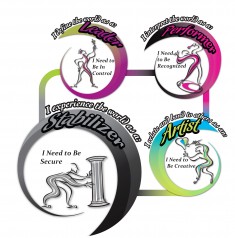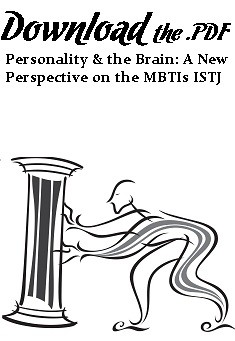Personality & the Brain - A New Perspective on the MBTI's ISTJ
Personality & the Brain - A New Perspective on the MBTI's ISTJ
Through the lens of the Striving Styles, each of the Myers-Briggs (MBTI®) 16 Types comes alive. Discover which quadrant of the brain the ISTJ prefers to use, what the predominant, innate psychological need that drives the ISTJ's behavior is, as well as how an ISTJ can leverage their whole brain in order to develop and achieve their potential.
Four Quadrant Model of the Brain
The SSPS shows that each of the four quadrants of the brain has their own role, or function, to play in our personality and our consciousness. Based on Jung's Theory of Psychological Type, we are hard-wired to prefer one function or quadrant over the others and we use each quadrant or function in either an inwardly or an outwardly way.
The ISTJ's Predominant Striving Style is the Stabilizer, which is rooted in the left emotional brain (Jung's Sensing function) and focused internally. This is the part of the brain responsible for experiencing physical sensations. The most mechanistic of the four quadrants, it repeats activities in an impersonal and automatic manner in order to produce desired sensations. Present-oriented, this part of the brain sequences and sorts, focusing on what has to be done now, and following instructions to the letter. Precise and procedural, it doesn’t reflect on the “why” of things, only on the “how.” It completes tasks without the need to understand the big picture.
This quadrant is connected to the processing of positive emotions and relatively complex emotions. Its goal is to produce sensations, not feelings, and it tends to sort and quickly filter out experiences that it labels “bad.” Because it seeks to experience what has been experienced before, it can cause us to keep repeating unpleasant sensations we have experienced in the past, and it doesn’t consider the emotional consequence of doing so.
Drivers of Human Behavior: Needs & Emotions
Each of us is driven by powerful, instinctual needs and have been since birth. These needs are a source of motivation and influence our behavior. When our predominant need is met, we are poised for growth. When our need is not met, fear and anxiety override rational, leading to self-protective or survival behaviors.
ISTJs, as Stabilizer Style people, have a predominant need to be secure. Steadfast, reliant and loyal, the Stabilizer is the “Backbone of Society,” intent on building the solid foundation on which they ensure physical safety for themselves, their families and their community. Stabilizers will follow through with commitments, regardless of their own personal needs, and will work tirelessly to get a job done. Often deeply introverted, they reveal themselves by what they produce and build. They excel at followership.
When their need to be secure is frustrated, the Self-Protective System of the Stabilizer (ISTJ) is activated, causing survival behaviors to emerge including:
- Conform strictly to rules and regulations; expect others to do the same; resent or fear those who don’t
- Resist change and plan obsessively; hold rigidly to methods and ideologies that are known
- Say yes to everyone who asks them for help; do not even think that they have the option to say no
- “Catastrophize” about what might happen in the future; fail to take action because of their fearful thoughts
Using the Whole Brain: Striving Style Squad
Going beyond the descriptors of the MBTI, the SSPS shows people how to access and integrate all four quadrants of their brain in order to use their whole brain as it is intended. There are four Styles that make up a person's Striving Style Squad, each with its own role to play in our personality based on where they reside in the brain.
The Striving Style Squad for the ISTJ is: Stabilizer Predominant Style with Leader, Performer & Artist Associate Styles. Each Associate Style on the Squad also has a specific need that must be met and different innate talents that allow it to meet that need. Often, we neglect the development of the Associate Styles, resulting in the overuse of our Predominant Style which is a detriment to our confidence and mental health.
If we are not using the appropriate quadrant of our brain and its associated Style for its intended purpose, we end up using a different part of our brain in a way that it was not intended to be used. This can limit our flexibility, drain us of valuable internal resources, and ultimately thwart our development and growth in life.
Want to know more about the Striving Style Squad of the ISTJ? Download our PDF now!
To learn about the other MBTI Types, click here.

Stabilizer Left Striving Style Squad: Stabilizer Predominant with Leader, Performer and Artist Associates. Learn how to develop the whole brain of an ISTJ with our Leveraging Your Squad Report.

Join us for one of our upcoming webinars. We offer a variety of webinars on other topics to help you take the MBTI to the next level! LEARN MORE...







